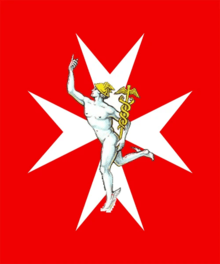234 Signal Squadron (United Kingdom)
234 Signal Squadron is a specialist signals unit of the Royal Corps of Signals within the British Army. The squadron was formed with the original purpose of provided signals to the Malta Infantry Brigade. Today, the squadron is part of the Joint Service Signal Unit, Cyprus and provides communications to units based in Cyprus for their Operation Tosca deployments.
| Malta Command Signals 234 Signal Squadron (Malta) | |
|---|---|
 Badge of the Squadron | |
| Active | 1923—1979 1993—Present |
| Country | |
| Branch | |
| Type | Signals Regiment |
| Role | Military Communications |
| Size | Squadron |
| Part of | Joint Service Signal Unit, Cyprus |
| Garrison/HQ | Ayios Nikolaos Station |
| Nickname(s) | 234 Sqn |
| Engagements | World War II |
History
In 1923 following the formation of the Royal Corps of Signals in 1920, the War Office decided to form a new specialist signals unit for the Malta Garrison. This unit became known as the Malta Signals Section. After forming, the section was mostly manned by Maltese civilians and a limited number of British officers. Just before World War II, the section was expanded to company size and renamed as Malta Command Signal Company. By this time, the company was commanded by Lieutenants T. De B. Miller BA and W. C. Ramsay. By October 1939, because of the beginning of the war, the Malta Command established a new position, Command Signal Officer. After formation, this role was filled by Major F H Bury who was promoted to Major on 6/6/37.[1][2][3][4][5]
In 1947 following the end of the war, the company was renamed as the Malta Signal Squadron. And in 1949, the first group of locally enlisted members joined the squadron. By 1959 the squadron was renamed as 234 Signal Squadron (Malta) as part of the general numbering and reorganisation of the Royal Corps of Signals. During this time, the squadron not only supported Malta Command, but also supported HQ Malta and HQ Libya until its disbandment. In 1974 Malta gained their independence and the squadron was disbanded in 1979. During their time on the island, the squadron maintained a troposcatter in Gozo.[4][5]
In 1993, the 9th Signal Regiment (Radio) gained a new squadron, this new squadron was known as 234 Signal Squadron. As a result the squadron's traditions continued through this new formed squadron. After being renumbered, the squadron was based in Cyprus where it continued to support the new Joint Service Signal Unit, Cyprus.[4][5]
The squadron today is part of the Joint Service Signal Unit, Cyprus.[6][7]
References
- "The Army List" The Monthly Army List, September 1939 Edition https://deriv.nls.uk/dcn23/1055/2061/105520616.23.pdf
- Niehorster, Leo. “Malta.” Malta, 03.09.1939, Dr Niehorster, http://niehorster.org/017_britain/39_army/malta.html.
- "The Army List" The Monthly Army List, October 1939 Edition https://deriv.nls.uk/dcn23/1059/9109/105991093.23.pdf
- Lord and Watson Page 95
- British Army Units from 1945
- Army 2020 Refine Order of Battle (Updated August 2019). (2019). [ebook] Available at: https://britisharmedforcesreview.files.wordpress.com/2019/08/army-2020-refine-orbat-6.pdf [Accessed 26 Aug. 2019].
- Lord and Watson Page 42
Sources
- Lord, Cliff, and Graham Watson. The Royal Corps of Signals Unit Histories of the Corps (1920-2001) and Its Antecedents. Helion and Company, 2003. ISBN 1874622922
- “British Army Units from 1945 On.” British Army Units from 1945 on - 234 to 236 Squadrons, http://british-army-units1945on.co.uk/royal-signals/squadrons-2/234-to-236-squadrons.html